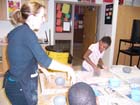Alicia St.GermainŐs
Literacy Philosophy

Reading in my
classroom will look very different from reading that happens in a language art
or history class. While it is important for students to be developing
vocabulary and descriptive language to become better communicators, it is also
vital for them to develop the abilities to discriminate and interpret visual
actions, objects, and other images, while gaining meaning from them through
visual literacy. My art classroom will be a center for the introduction, deconstruction
and execution for developing my studentŐs visual learning through the ability
to understand and use images. To a degree we are all visual learners, whether
with crayons or computers, kids like doing art. Well-conceived projects and
activities that introduce graphic and multimedia arts are not only fun, they
help kids expand their creative skills. Visual learning is best achieved
through: taking notes and making lists to read later, reading information to be
learned, learning from books, videotapes, filmstrips, and printouts, and the
most vital aspect of the art classroom through seeing hands on demonstrations.
Demonstrations are excellent opportunities for developing studentŐs vocabulary of art terms and materials. In my own lesson plans I plan to use hand-outs with specific vocabulary term lists that I expect students fill out and note as I progress through a demonstration or during an informational video. This simple activity requires students to develop their attention and observational skills, while allowing me to observe and question students for understanding of the demonstration. Then after students have applied the knowledge gained from observing a demonstration and produce a final art piece I can then asses their knowledge of what has been learned by asking them to write a reflection about what they have done, how they progressed through the activity, and what they would do differently. These simple questions allow for students to develop and use their analyzing, descriptive, and critical thinking skills, while also helping to develop their own personal point of view and art appreciation. Another form of writing that I intend to use in my assignment would include creative writing assignment that would be used in conjunction with art works, For example I may have students study the process of producing a cartoon cell where they would create their own character to interact in different backgrounds. Students then would supplement this assignment with a brief writing about their creation. Since the class main focus is to evaluate what is learned from the workshop process evaluating studentŐs penmanship and grammar mistakes would not be stressed but creativity and freethinking encouraged.
The art classroom walls are key to developing a stimulating environment for visual literacy education. Wall displays containing variants of an assignment, informational posters, time lines, student show cases, and inspiring imagery and quotes as well as rules, safety precautions, and shelves lined with art reference materials work together to create a fun and informational center for learning. Poster series such as the Elements & Principles of Design Poster Set are Art posters containing excellent visual representations of various artist and elements of design. These Colorful, graphic posters help to take the mysteries out of design. Text and illustrations are designed to help students develop their knowledge and skills. The set contains seven 17x22Ó element posters: value, color, form, shape, line, space and texture. Seven 17x22Ó principle posters: contrast, rhythm, unity, emphasis, pattern, movement and balance. All of which can either be permanently displayed throughout the room or revealed and discussed with the class during individual lessons. The classroom library is perhaps the second greatest resource in the art classroom (the art teacher is the first). My class room resource center will contain a variety of art history informational books, reference dictionaries, specific artist references, Ňhow toÓ books, science and visual cultural magazines, artist series DVDs, and a classroom computer with assess to the internet for an almost endless source of visual referencing and inspiration.
Our modern
industrial society is continually becoming a world of visual literacy images
that are all around us. Most students spend much of their time looking at
television screens, web graphics, print illustrations, and other types of
visual displays. By providing a visual literacy education in the art classroom is
important to contributing to a studentŐs ability to interpret these displays with
meaning and understanding for the vital development of all around thinking and
learning.